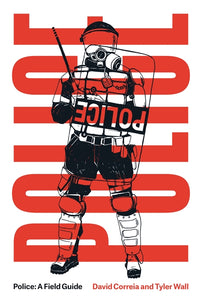The definition of "chokehold"
At least since the late 1970s and early 1980s, the Los Angeles and New York police departments used and justified chokehold techniques, while at the same time banning and sanctioning some versions of the technique. In a five-year period in the 1980s, LAPD officers killed sixteen people with a chokehold, and fourteen of these deaths were of Black people.

An excerpt from Police: A Field Guide by David Correia and Tyler Wall, a radical glossary of the vocabulary of policing that redefines the very way we understand law enforcement. Now available as a FREE ebook here.
Strangulation, asphyxiation, choking—these have long been mainstays of cops whether in liberal democratic or totalitarian regimes.1 Robbing the breath of someone held in state custody—detained, arrested, interrogated, imprisoned—is a central mode of police control and coercion. A vast catalog of strangulation and asphyxiation techniques has been designed, used, criticized, abandoned, and reformed over the years.
The chokehold is both the most common police strangulation method and, in the United States, one of the most controversial. The chokehold that slowly squeezed the life out of Eric Garner on a New York street in 2014 is the most recent and well-known example. At least since the late 1970s and early 1980s, the Los Angeles and New York police departments used and justified chokehold techniques, while at the same time banning and sanctioning some versions of the technique. In a five-year period in the 1980s, LAPD officers killed sixteen people with a chokehold, and fourteen of these deaths were of Black people. The LAPD chief at the time, Daryl Gates, even went so far as to say that “some Blacks” were more susceptible to death by chokehold due to the biological makeup of their arteries compared to “normal people,” and then banned the practice. But following the beating of Rodney King, Gates commissioned a study on the reintroduction of the chokehold, arguing that reviving the chokehold as pain compliance would limit the use of the nightstick.2 Police offered the chokehold as police reform, as something that makes police violence more “humane,” “less lethal,” and so more hygienic.
Police have various terms to euphemistically describe an acceptable chokehold, such as “carotid control hold” or “vascular restraint.” Police depict the problem of the chokehold as a problem of training. It is deemed excessive by police to force someone unconscious by placing direct pressure or force against a subject’s windpipe, but it is acceptable to cut off blood flow by applying pressure to the carotid artery. But tell this to the person being strangled, for whom the distinction between acceptable and unacceptable chokeholds means very little.
And the chokehold is not the only way that police strangle and asphyxiate people. Strangulation and choking have long been an interrogation tactic used to force a confession. The first federal investigation of police practices, the 1931 Wickersham Commission, investigated various police methods, including waterboarding, in which cops pour water slowly down a person’s nostrils in order to simulate a drowning in order to force a confession. Police did not invent this tactic, but it and other forms of drowning techniques have long been part of the police project.
Cops also choke suspects or detainees with their neckties or scarves. As neckties became less common, police improvised and found other methods to rob someone of their breath. One of the most common ways police choke people echoes the torture of prisoners by the US military at Abu Ghraib prison in Iraq. Called “bagging” or the “dry submarine,” a cop puts a plastic bag or cloth sack over a detainee’s head while sealing the bottom. This became a popular practice among Chicago and New Orleans police in the 1970s and ’80s.
Police reformers claim bagging is no longer common police practice. But it hasn’t disappeared, only morphed into a different form. Police now place “spit hoods” over suspects’ heads in order to prevent them from spitting on or biting officers. Police officials insist the hoods, made of mesh or heavy canvas, are not designed to suffocate or asphyxiate suspects, but Jack Marden would disagree if he could. When Midland County, Michigan police arrested the fifty-six-year-old Marden on a felony assault warrant, they alleged he became aggressive with police and demonstrated erratic behavior, such as stripping down naked and yelling incoherently. Police eventually restrained Marden by hitting him in the head, tying him to a chair, and strapping a spit hood over his head. Marden eventually died, and a lawsuit alleges that police killed him by suffocation.
Police describe the spit hood as a humane alternative to force. It is, in other words, a gentler method of restraint than the nightsticks, Tasers or fists that would otherwise be used. But the result is often the same: terror and death. In addition, police routinely use what are called EDP bags, an acronym for “emotionally disturbed person.” Police use them to totally restrain subjects by zipping them up into a full-body container. Some versions cover the whole body including the head. It is no accident that this technology of police reform looks a lot like a body bag for the dead.
1 Rejali, Darius, Torture and Democracy, Princeton University Press, 2007.
2 Skolnick, Jerome H. and James J. Fyfe, Above the Law: Police and the Excessive Use of Force, The Free Press, 1993.

